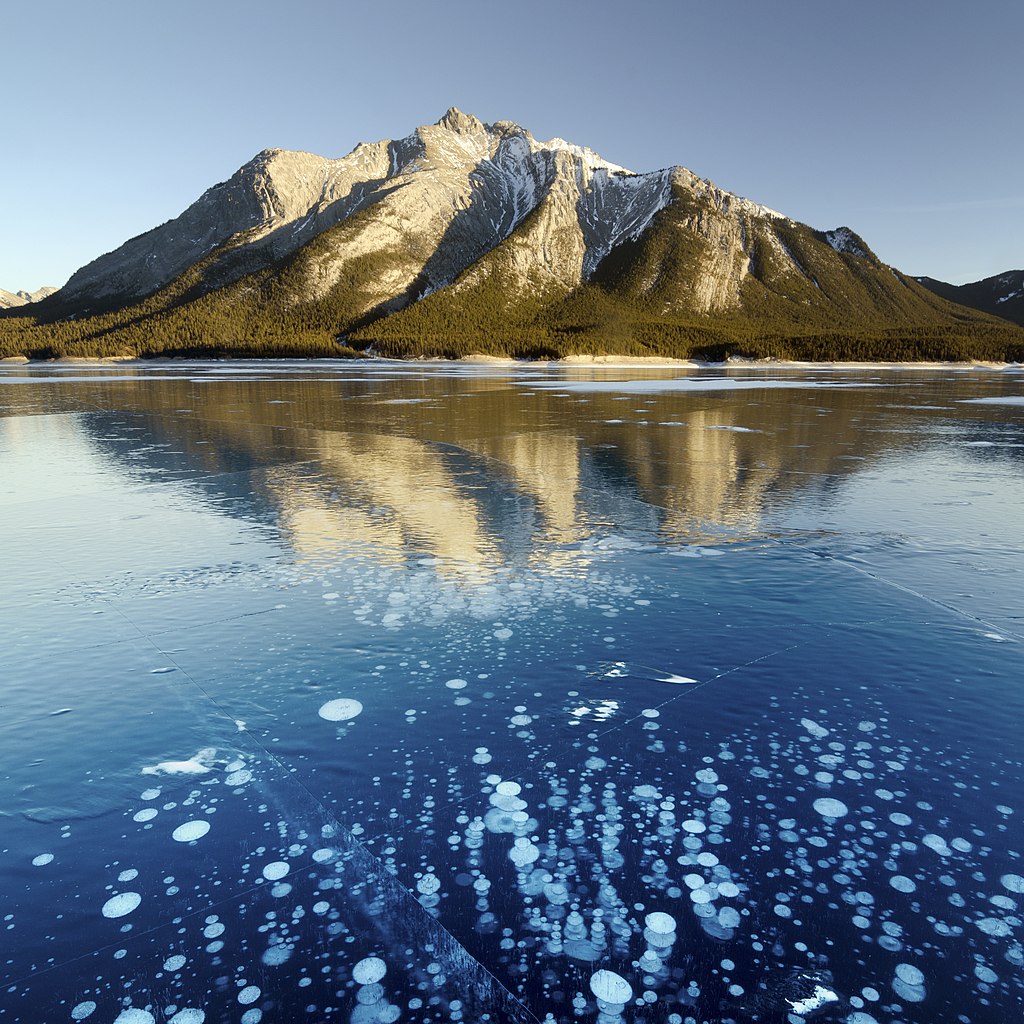What is methane?
Methane with a chemical formula CH₄ is a type of a hydrocarbon, and the simplest member of the paraffin series, and among the most potent greenhouse gases. It is a colorless and odorless gas that occurs abundantly in nature due to certain human activities and anaerobic bacterial decomposition of vegetable matter underwater (sometimes called marsh gas or swamp gas).
Natural production of methane is occurring plentifully in wetlands and lakes. Termites (because of digestive processes) are another important natural source of methane, volcanoes, vents in the ocean floor, and methane hydrate deposits that occur along continental margins and beneath Antarctic ice and Arctic permafrost.
Methane is also a significant natural gas component, containing 50 to 90 percent methane (depending on the source) and occurs as a component of firedamp (flammable gas) along coal seams.
In Alberta, methane plays an important aesthetic appeal to locals and tourists that visit Abraham Lake. During winter, temperatures sink below zero, and wind speeds can reach 48 kilometers per hour. Rocky Mountain vistas frame many fantastic water bodies, and some are made even more striking, just like the strangely beautiful frozen methane bubbles beneath the lake’s surface. The unusual ice that forms on the lake’s surface is very clear, giving visitors a fantastic glimpse of the frozen bubbles below.
These large and tiny white bubbles are formed by water-dwelling bacteria that feed on decaying organic matter and expel methane gas. The methane gas is trapped and suspended on ice when the water freezes during winter. The bubbles in the artificial lake are so prominent along the David Thompson Highway southwest of Nordegg, and they attract visitors in wintry months.
Besides Lake Abraham, you can see methane bubbles in other water bodies around the province when the conditions are right. You can see frozen methane bubbles in the following places:
Barrier Lake- west of Calgary in Kananaskis. Turn south on Highway 40 from the Trans-Canada Highway.
Spray Lakes – a short drive west of Calgary and just south of Canmore,
Calgary’s Elbow River
Lake Bonavista – at Calgary’s southeast.
Banff National Park’s Lake – Minnewanka, in the northeast of the Banff townsite.
Although they look beautiful and unique, these methane bubbles frozen on the lake have a dark and dangerous side. Despite their natural occurrence, the alluring ice-encased bubbles enclose a hazardous greenhouse gas that is a threat to the planet once the winter is over.
When the lake thaws in spring, the bubbles pop, and methane gases are released into the atmosphere. One dangerous characteristic of methane is highly flammable, and so the bubbles can explode when set alight. The real danger is in its impact on Earth’s temperature. Although methane gas doesn’t stick around in the atmosphere, unlike carbon dioxide, yet its heat-trapping effect is 34 times stronger, making it potentially far more detrimental to our climate.
Canada is not the only country that faces this lovely-but-pressing environmental issue. Thawing bogs in Siberia are being studied and observed by Russian, and US scientists as methane emissions are also measured.
What can methane emissions cause our planet and to all living beings?
Natural gas comprised mainly of methane is the cleanest burning fossil fuel, but when methane is a by-product of non-fossil sources like food and green waste, it can take carbon out of the air.
However, when methane is released into the atmosphere before it is burned causes harm to the environment as it can trap heat in the atmosphere and contribute to climate change. Although it only stays short in the atmosphere than other greenhouse gases, it is more efficient at trapping heat than are those other gases.
There are natural ways to remove methane from the atmosphere, but human activities also contribute to this gas’s amount in the atmosphere. Therefore, human activities must be done in ways that reduce their methane emissions. A good example is capturing and using methane from wastewater treatment plants or dairies to be used as a fuel to reduce the amount of methane entering the atmosphere and reduce dependency on fossil fuels.
Methane is not always on the negative side. It also provides significant environmental benefits by producing more heat and light energy by mass while having significantly less carbon dioxide and other pollutants that contribute to smog and unhealthy air. Methane can substitute coal in generating electricity or gasoline to fuel cars, trucks, and buses. The less greenhouse gas emissions and smog-related pollutants are produced.


